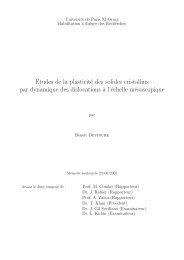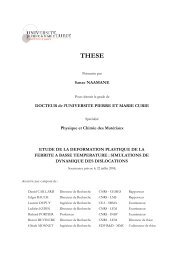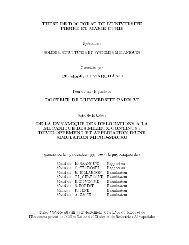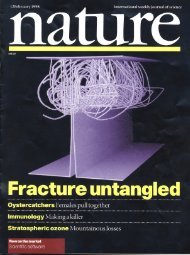Acta Materialia, 58(17) - Laboratoire d'Etude des Microstructures
Acta Materialia, 58(17) - Laboratoire d'Etude des Microstructures
Acta Materialia, 58(17) - Laboratoire d'Etude des Microstructures
Create successful ePaper yourself
Turn your PDF publications into a flip-book with our unique Google optimized e-Paper software.
5590 S. Queyreau et al. / <strong>Acta</strong> <strong>Materialia</strong> <strong>58</strong> (2010) 5<strong>58</strong>6–5595<br />
Fig. 3. Critical shapes of a screw dislocation interacting with a periodic row of particles respectively (a) free of loop, (b) with one Orowan loop, (c)<br />
circumvented by four Orowan loops, and (d) sketch of the quasi-static equilibrium obtained between the curved mobile dislocation and the repulsive<br />
Orowan loops stored around the particles. For the sake of clarity, a single particle is drawn.<br />
progression is difficult and island loops are sometimes<br />
formed around groups of particles. In Fig. 4, a thin foil<br />
extracted from the 3-D simulated volume emphasizes new<br />
features induced by dislocation–dislocation interactions<br />
out of their glide plane. As highlighted in Fig. 4 inset, dipoles<br />
and multipoles are formed during plastic deformation and<br />
those dipolar configurations are not randomly localized<br />
but stay preferentially between the closest particles.<br />
As in the simple case of a periodic array of precipitates,<br />
significant dislocation storage is found as a result of Orowan<br />
loop and island loop formation. This important dislocation<br />
storage justifies the large strain hardening observed<br />
in the simulation. As illustrated in Fig. 5a, plastic flow<br />
starts at a relatively high applied stress around 70 MPa,<br />
and with increasing strain the flow stress continuously<br />
increases up to 78 MPa at c = 1%. This strain hardening<br />
results from the long-range elastic field associated with<br />
Orowan loops, the source-shortening effect and the dipolar<br />
interactions. The last contribution is relatively weak at<br />
small plastic strain.<br />
In Fig. 5a, comparison is made between stress–strain<br />
curves obtained with and without carbi<strong>des</strong>. This is to<br />
differentiate the contribution of carbi<strong>des</strong> and of dipolar<br />
interactions. Without carbi<strong>des</strong>, the flow stress is as high<br />
Fig. 4. Simulated microstructure resulting from the interaction between a single slip system with a random distribution of carbi<strong>des</strong>. s = 75 MPa and<br />
c = 1%. The thin foils extracted from the simulated volume have a thickness of 0.2 lm and are parallel to the dislocation glide plane. The enlargement (A)<br />
shows the formation of dipoles and multipoles aligned along the smallest carbide spacing.









